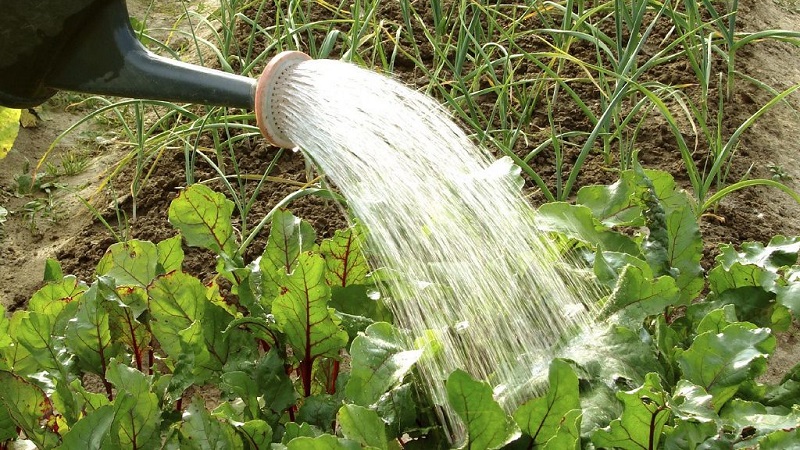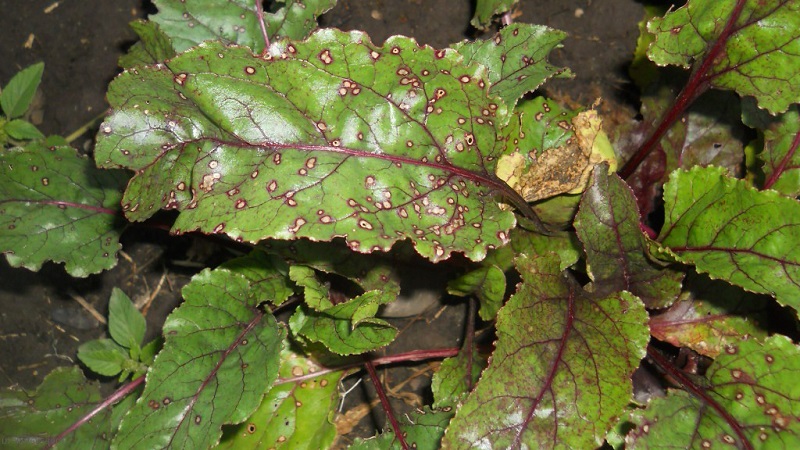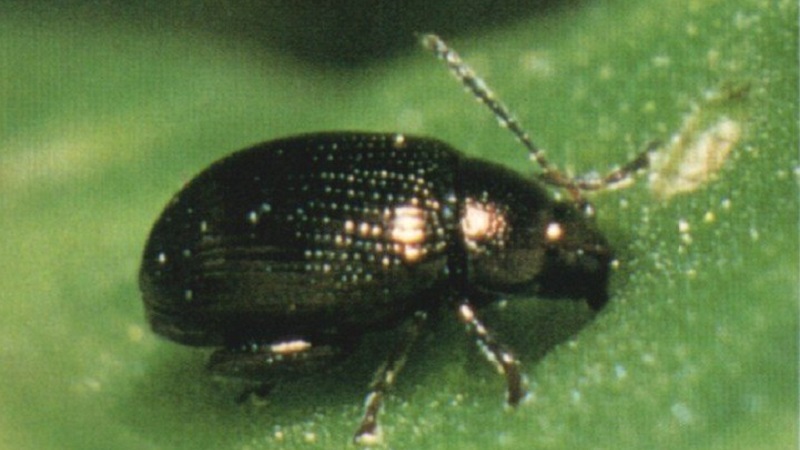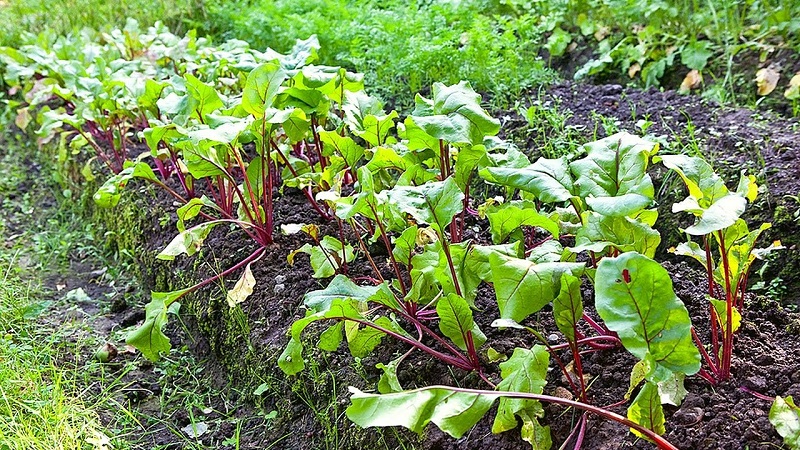What to do when beet leaves turn yellow and it does not grow?
Errors in the care and process of growing root crops are reflected primarily in the greenery of the plant. The foliage turns yellow, dries, becomes stained, dies off. Beets are no exception.
Yellowing of beet leaves is a sign of disease or improper plant care. In the article we will tell you what to do when the leaves of the beet turn yellow and it does not grow.
The content of the article
The main causes of leaf color change
The state of the greenery is an indicator of the correct development of the root crop... A healthy vegetable has rich, bright green leaves. Why do beet leaves turn yellow in the garden? It is natural to observe the drying and dying off of the lower leaves of the beet in August, when the vegetable is almost ripe and ready to be removed from the garden.

If the lower leaves turn yellow in July, this means that the beets need help.
The main causes of yellowing and drying of beet tops:
- insufficient watering;
- lack of nutrients in the soil;
- invasion of pests;
- infection with diseases.
Lack of moisture and nutrientsnitrogen in particular are the main causes of problems with beet tops. But other negative factors also deserve separate consideration.
Lack of moisture in the soil
Beets are not moisture-loving crops... However, for the growth and development of root crops, they need regular moisture in the soil. The frequency of watering beet beds depends on the weather conditions and the phase of plant growth.
Watering regime is observed from the moment of sowing seeds... Sow the beets in well-moistened soil. Before mass shoots appear, ensure that the soil is constantly moist. Since young shoots are still weak and the root system is not developed, deep hydration is not required.
Important! Beets experience the greatest need for water during the period when root crops begin to form.
During the formation and intensive development of the root crop watered abundantly - up to 20 liters per 1 sq. m. Watering is stopped 2-3 weeks before harvesting.

In hot, dry summers, water abundantly and regularlyoh, about once a week. Poor daily irrigation is a mistake. So only the top layer of the soil will be moistened, and the root crop will receive little water. If summer does not pamper with warm weather, then enough humidification at the rate of 10 liters per 1 sq. M. beds.
Advice... Avoid watering during the day or the sun will burn wet foliage.
It's important not to overdo it. Excess moisture is just as bad for the plant as lack of moisture.... Waterlogging leads to a decrease in the oxygen content in the ground, causes rotting of the root system and provokes the development of pathogenic microbes.
Read also:
Lack of nutrients and trace elements
Another common cause of yellow leaves is lack of nutrients in the soil.
Beet tops reacts differently to a lack of a certain substance.y: turns yellow, turns red, becomes stained.
Yellow foliage signals a lack of nitrogen. It is this substance that is responsible for the formation of the tops of root crops.
With nitrogen starvation the leaves grow small and lethargic, and then change color.The veins turn yellow, thicken and coarse first, and then the entire leaf as a whole.
Redness of foliage indicates a lack of magnesium. Leaf spots and dying off of the tips are a sign of iron deficiency.
Besides, the culture is sensitive to the insufficient content of boron and manganese in the soil... This problem is typical for sandy and calcareous soils.

Disease Infection
The coloring of the tops in a yellow-green color often indicates the development of the disease.... This symptom is typical for downy mildew, brown rot, cercosporosis, black leg, rust, jaundice.
Downy mildew
Downy mildew - it is a fungus transmitted by infected plant debrisas well as with wind and water. Deformation of the leaves, the appearance of a gray-purple bloom, yellowing and wilting indicate infection.
Brown rot
Brown rot - it is a disease that affects the root crop itself... An infection is recognized by underdeveloped tops, its yellowing and dying off, beet decay during winter storage.
Rust
Disease manifested by the appearance of round orange spots on the leaves... After a while, they also appear on the petioles and stems. Photosynthesis is disrupted in the affected plants, the foliage turns yellow and dies.
Black leg or root
Korneed - root system disease caused by a complex of soil fungi and bacteria. Disease symptoms: yellow, limp leaves. The development of infection provokes excess moisture.
Cercosporosis
Cercosporosis – it is a fungus, manifested by the appearance of light spots with a brown border... After a while, the leaves dry, turn black and wither.

Jaundice
The disease is characterized by yellowing of the lower and middle leaves.... The disease begins from the tops of the leaves, then spreads along the edges and between the main veins of the leaf. Aphid can transmit this disease. Weeds can also be a source of infection.
Insect pests
The invasion of parasites is another reason why beet tops change color and fall off.
The most dangerous parasites are for immature young plants... There are few insects that can damage the beet crop. Let's talk about each of them in more detail.
It can be useful:
Instructions for planting beets in the spring in open ground
Beet aphid
It is a wingless black insect with a greenish or brown tint. The larvae are light, dark green. Aphids lay black, shiny eggs.
The pest is common where euonymus, viburnum, jasmine grow... In autumn, the aphid lays eggs on these shrubs. In spring, larvae develop from eggs. When the leaves of the shrubs become tough, the aphids move to the beet beds, where they breed until autumn. With the arrival of cold weather, aphids again move to euonymus and viburnum and lay eggs there.
The parasite is dangerous because it sucks the juices from the plant... The leaves dry, the tops are deformed and curled. Damaged leaves turn yellow, the edges and tops turn down, wither and dry out. Vegetable growth slows down, roots grow small and unsightly.
Common beet flea
The beetroot flea is a small, bronze-colored beetle with spots on the wings. The pest (pictured below) hibernates in closed places (forest belts) and becomes active in April-May. It feeds mainly on young beet sprouts and weeds. Lays eggs in the soil in late spring. The larvae, after birth, eat the roots of plants.

They recognize a flea by small holes in the leaves and petioles... If there are many pests, the leaves become lace-like.
Beet shields
Flat beetle green or brown, 6-7 mm in length... It hibernates under plant debris and fallen leaves, as well as in thickets of weeds. Shieldweed appears in April-May and settles on weeds and beets.Females lay eggs on beet leaves, from which larvae emerge. Young individuals, like beetles, feed on leaves, gnawing holes.
Larvae do the most harmthat completely eat up the leaves without touching the veins.
Beet miner fly
It is a gray-brown pest 6-7 mm in length... Larva 6-8 mm pale yellow with a wrinkled body surface.
Lays eggs on the underside of beet leaves... The hatched larvae gnaw through the leaf and penetrate, forming cavities (mines) inside. From the outside, the damaged area looks like a bubble. Damaged tops turn yellow and dry out. Damage to beets at the initial stage of growth is especially dangerous.
Beet weevil
Gray-brown beetle... Its length is 12-16 mm. The pest is capable of destroying beets in large areas. The beetle crawls out of its wintering grounds in late April - early May, when the soil warms up to + 10 ° C.
First, the pest eats fresh leaves of quinoa, shiritsa and mari, then moves to the crops of beets. The sprouts are still small at this time. As soon as the beetle bites on the cotyledon leaves, the plant loses its ability to develop.
Weevil lays eggs in the soil... The larvae hatch after 11 days and gnaw the roots of the beets in the soil. Because of this, roots grow irregularly shaped.
How to deal with yellowing of the tops
How to deal with this? First, the source of the problem is identified.
The lack of moisture is corrected by regular and abundant soil moisture... The watering rate for beets is about 15 liters per 1 sq. m. When watering, make sure that the water in the beds does not stagnate. If this happens, the rate is reduced.
As soon as the root vegetable starts to gain weight, the frequency of watering is reduced. Water less often in rainy and cool weather. In August, the amount of applied liquid is reduced. 2-3 weeks before removing the root crops from the garden, watering is stopped.
Lack of nutrition is compensated for by root and foliar feeding... A quick effect is given by feeding with infusion of mullein or chicken manure (1 kg per bucket of water). Fertilizer is applied between rows (1 bucket per 10-15 running meter). The top dressing on the leaves is washed off with clean water. All liquid dressings are carried out in July. During this period, the most active consumption of all nutrients occurs.
If the problem is caused by disease, the plants heal... With brown rot, beets are treated with boron. With black rot, they get rid of high soil moisture and loosen the ground. Acidic soils are fertilized with lime.
To prevent infection with cercospora, the seeds are heat treated. If the disease appears, the foliage is treated with chalk and the plantings are fed with a boron solution.
If rust is found crops are sprayed with fungicides. It is important to avoid high doses of nitrogen fertilizers and grow disease resistant varieties.
For pest control use spraying with insecticides, tobacco infusion, soap solution. Good results are obtained by using a decoction of wormwood.
Attention! Spraying is carried out as soon as the pest is detected, before the leaves roll.

Prevention measures
To avoid problems when growing beets, for planting crops are prepared in advance. Prevention of yellowing and drying of beet leaves includes ensuring adequate nutrition of crops, adherence to the irrigation regime, timely removal of weeds, and compliance with crop rotation.
Yellowing of the tops is most often caused by nutritional deficiencies... Therefore, it is important to periodically apply all the necessary fertilizers. Mid-ripening and late-ripening varieties of the culture are fed at least twice. The first - after the appearance of the first leaves, the second - after 3 weeks.
Important! Observe the measure when applying fertilizer. Remember that roots store nitrates.
To avoid infection pests, beds and aisles are thoroughly treated, weeds are weeded and removed from the garden.The beet leaves affected by the miner fly are cut off and removed from the site. In autumn, the soil is dug up and thoroughly cleaned of plant residues and foliage. So the parasites will lose their wintering places.
A simple way to protect yourself from the invasion of parasites - attracting predatory insects to the garden plot. They are faithful helpers in pest control. Ladybugs and lacewings destroy aphids. Beneficial insects are attracted by sowing plants such as calendula, cornflower, dill, geranium, tansy.
Reference. Insecticide treatment destroys not only pests that quickly recover, but also beneficial insects.
Prevention of beet diseases consists in the disinfection of the seed, cleaning the site in autumn and burning plant residues, killing weeds, loosening the soil. For planting, choose varieties that are resistant to pathogens and harmful insects.
When harvesting, the roots are protected from mechanical damage, protect from freezing. The harvested crop of root crops is carefully sorted out before storage in order to prevent the possible spread of diseases.
Conclusion
The emerald greens of young beets are an indicator of the health of the root crop. Competent fertilization, adherence to the irrigation regime, the fight against diseases and pests can avoid yellowing and drying of beet leaves.